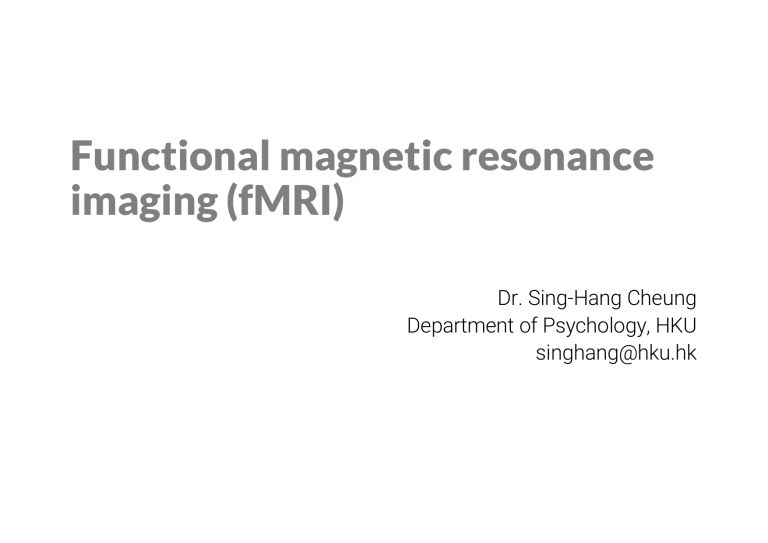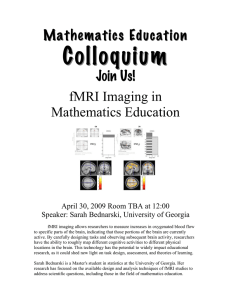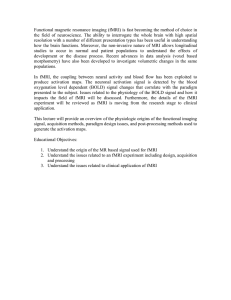
Functional magnetic resonance imaging (fMRI) Dr. Sing-Hang Cheung Department of Psychology, HKU singhang@hku.hk Outline • What is fMRI? • The fMRI signal 2 Functional magnetic resonance imaging (fMRI) fMRI becomes increasingly popular 3 Functional magnetic resonance imaging (fMRI) (Smith, 2012) From what you had heard, what can functional magnetic resonance imaging do? 4 Functional magnetic resonance imaging (fMRI) Who are you looking at? 5 Functional magnetic resonance imaging (fMRI) (VanRullen & Reddy, 2019) Franz Joseph Gall (1758–1828) • Question explored • How are mental functions mapped onto different brain regions? • Gall proposed that individual differences in mental ability and personality can be inferred by the relative sizes of different brain regions, which can be observed as changes in the local shape of the skull. • This is called phrenology. • Method used • Gall examined the shape of the skull of different people. 6 Functional magnetic resonance imaging (fMRI) [Phrenology is] the study of the conformation of the skull as indicative of mental faculties and traits of character, especially according to the hypotheses of Franz Joseph Gall (1758–1828), a German doctor, and such 19th-century adherents as Johann Kaspar Spurzheim (1776– 1832) and George Combe (1788–1858). 7 Functional magnetic resonance imaging (fMRI) https://www.britannica.com/topic/phrenology Is fMRI new phrenology? • In his book “The New Phrenology,” Uttal (2001) criticized that some fMRI studies might have focused too much on the localization of functions. • Poldrack (2010) argued that mapping mental function to brain structure remained an important goal in cognitive neuroscience. However, the goal should be the identification of selective associations. 8 Functional magnetic resonance imaging (fMRI) Conventional fMRI research strategies • Poldrack (2010) mentioned three often used research strategies in neuroimaging studies—(1) the “where” strategy, (2) the “what” strategy and (3) the “fractionation” strategy. • The “where” strategy • Manipulates engagement of a mental process (A) • à Identifies brain regions with corresponding changes in activity • Brain regions X, Y and Z are involved in mental process A. 9 Functional magnetic resonance imaging (fMRI) (Poldrack, 2010) Conventional fMRI research strategies • The “what” strategy • Manipulates two or more mental processes • à Examines relative responses in a brain region of interest (X) • Brain region X is more about one mental process over the other. • The “fractionation” strategy • Manipulates two or more mental processes (A and B) • à Identifies brain regions with selective changes in activity • Brain region X is involved in mental process A, and brain region Y is involved in mental process B. 10 Functional magnetic resonance imaging (fMRI) (Poldrack, 2010) Conventional fMRI research strategies • Assumptions • We know what mental processes to map. • We know what tasks to use to engage the mental processes of interest. • Poldrack argued that we need to work on the cognitive ontology. • We need a better understanding of the structure of cognitive processes. 11 Functional magnetic resonance imaging (fMRI) (Poldrack, 2010) Building blocks of the brain • Neurons Types of neurons 12 Functional magnetic resonance imaging (fMRI) • Glia Types of glia (in the CNS) https://qbi.uq.edu.au/brain/brain-anatomy/types-neurons https://commons.wikimedia.org/wiki/File:Blausen_0870_TypesofNeuroglia.png Neuronal activities • The main actions in the brain involve communication of signals, which can be understood through two aspects of neuronal activities: 1. Signaling • through action potentials 2. Integration • through synaptic activities 13 Functional magnetic resonance imaging (fMRI) (Park, Kim & Lee, 2020) From neuron to fMRI • Neuronal activities involve changes in electric potential. • Changes in potential can be measured by using a (micro)electrode. • These changes require a lot of energy. • Increase in neuronal activities results in an increase in the flow of oxygenated blood. • The MR signal comes from the change in the amount of oxygenated blood. 14 Functional magnetic resonance imaging (fMRI) BOLD fMRI • The most commonly used fMRI method detects changes in the blood-oxygenation-level-dependent (BOLD) signal. 15 Functional magnetic resonance imaging (fMRI) (Arthurs & Boniface, 2002) fMRI and other tools in neuroscience 16 Functional magnetic resonance imaging (fMRI) https://www.nature.com/scitable/blog/brain-metrics/ Key reading • Mather, M., Cacioppo, J. T., & Kanwisher, N. (2013). How fMRI can inform cognitive theories. Perspectives on Psychological Science, 8(1), 108–113. https://doi.org/10.1177/17456916124690 • Guiding questions: 1. Mather, Cacioppo and Kanwisher (2013) mentioned four kinds of questions that could be addressed by fMRI studies? What were they? How did these four questions relate to cognitive theories? 2. Why was it important to have cognitive theories in fMRI research? 17 Functional magnetic resonance imaging (fMRI) Key messages • FMRI is a popular tool in neuroscience nowadays. • FMRI can (should) be used to test cognitive theories. • FMRI is an indirect measure of brain activities. • FMRI has limitations in spatial and temporal resolutions. 18 Functional magnetic resonance imaging (fMRI) Reference Arthurs, O. J., & Boniface, S. (2002). How well do we understand the neural origins of the fMRI BOLD signal?. Trends in Neurosciences, 25(1), 27–31. https://doi.org/10.1016/S0166-2236(00)01995-0 Park, Y., Kim, M. K., & Lee, J. S. (2020). Emerging memory devices for artificial synapses. Journal of Materials Chemistry C, 8(27), 9163–9183. https://doi.org/10.1039/D0TC01500H Poldrack, R. A. (2010). Mapping mental function to brain structure: How can cognitive neuroimaging succeed? Perspectives on Psychological Science, 5(6), 753–761. https://doi.org/10.1177/1745691610388777 VanRullen, R., & Reddy, L. (2019). Reconstructing faces from fMRI patterns using deep generative neural networks. Communications Biology, 2(1), 1–10. https://doi.org/10.1038/s42003-019-0438-y 19 Functional magnetic resonance imaging (fMRI)




